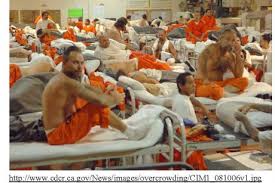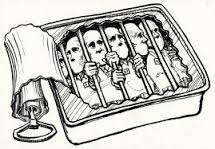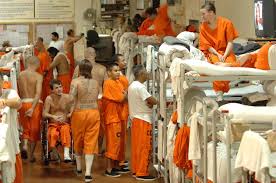A Well Thought Out Scream by James Riordan: California Reduces Prison Population

You’ve no doubt heard about the crowed prisons. The results of the “war on drugs”, the three strike laws and the mandatory minimum prison sentences have resulted in a hugely overcrowded prison population. The United States has about 5% of the world’s population and about 25% of the world’s prison population and, ironically, the state of California which until recently had imprisoned more people per capita than any other state, is leading the way in solving the problem.
 How did they do it? In the simplest way possible – they released thousands of prisoners before the end of their sentences. The big question now is what happens next. Of course, there is a great deal of concern that crime rates are going to rise, but that really has more to do with the parole and re-entry programs that the state offers than the number of ex-convicts who are out there. It’s been proven time and time again – if there are no jobs available for released inmates they will reoffend. If there are no other places for them to live than the neighborhoods they lived when they committed their crimes, they are likely to reoffend. And finally, if there are no programs to teach them how to acquire job skills, make new friends and learn to think differently than they did when they committed their crimes, of course they will reoffend.
How did they do it? In the simplest way possible – they released thousands of prisoners before the end of their sentences. The big question now is what happens next. Of course, there is a great deal of concern that crime rates are going to rise, but that really has more to do with the parole and re-entry programs that the state offers than the number of ex-convicts who are out there. It’s been proven time and time again – if there are no jobs available for released inmates they will reoffend. If there are no other places for them to live than the neighborhoods they lived when they committed their crimes, they are likely to reoffend. And finally, if there are no programs to teach them how to acquire job skills, make new friends and learn to think differently than they did when they committed their crimes, of course they will reoffend.
Sending a man to jail only keeps him from committing crimes w hile he is incarcerated. He must be taught a new way of living if he is to succeed. The State of California is attempting to do just that with their recent prison and jail reforms. The overcrowding in California prisons got so bad the state has been under federal court order since 2009 to bring its severely overcrowded prison system below 137.5 percent of capacity, or about 114,000 inmates. It met that modest goal in February, thanks in part to a 2014 ballot initiative that reclassified six low-level offenses as misdemeanors instead of felonies.
hile he is incarcerated. He must be taught a new way of living if he is to succeed. The State of California is attempting to do just that with their recent prison and jail reforms. The overcrowding in California prisons got so bad the state has been under federal court order since 2009 to bring its severely overcrowded prison system below 137.5 percent of capacity, or about 114,000 inmates. It met that modest goal in February, thanks in part to a 2014 ballot initiative that reclassified six low-level offenses as misdemeanors instead of felonies.
The initiative, Proposition 47, was expected to lead to the release of thousands of inmates, and cut new admissions by about 3,300 per year. It also required that the cost savings — estimated to be more than $150 million this year — be reinvested into anticrime services like drug rehabilitation, antitruancy efforts and mental health treatment. Victims’ services receive funding, too.
 Proposition 47 followed two other major reforms: A 2011 law diverted low-level offenders from state prisons into county jails, and a 2012 ballot initiative scaled back a “three strikes” law. The latter led to the release of more than 2,100 people who had been sentenced to life without parole, some for a third strike as minor as shoplifting.
Proposition 47 followed two other major reforms: A 2011 law diverted low-level offenders from state prisons into county jails, and a 2012 ballot initiative scaled back a “three strikes” law. The latter led to the release of more than 2,100 people who had been sentenced to life without parole, some for a third strike as minor as shoplifting.
After each reform, law enforcement officials predicted that crime would rise, but it continued to drop around the state. Recidivism rates of those released under the three-strikes reform are far below the state average.
Now, two new reports, by the American Civil Liberties Union and the Stanford Justice Advocacy Projec t, look at the effect of Proposition 47. The most easily measurable impact is on the state’s prison and county jail population, which has fallen by about 13,000, with more than 4,400 prison inmates released by the end of September.
t, look at the effect of Proposition 47. The most easily measurable impact is on the state’s prison and county jail population, which has fallen by about 13,000, with more than 4,400 prison inmates released by the end of September.
But the law remains controversial. Some in law enforcement argue that they can’t arrest people for small crimes anymore, and point to crime upticks in some counties. In fact, crime rates vary widely throughout the state. In Los Angeles County, property crime is up 8 percent, while the rate for all crime remains at record lows in San Diego County.
One sign that Proposition 47 is working is the recidivism rate. It is less than 5 percent for people released under the law; the state average is 42 percent.
 The reforms may be helping in another way. Because of severe overcrowding in county jails, local sheriffs had been releasing as many as 10,000 people from jail each month, regardless of the risks they posed, simply because there weren’t enough beds. By keeping more low-level offenders out of jail, Proposition 47 gives the authorities room to make smarter decisions about whom to release.
The reforms may be helping in another way. Because of severe overcrowding in county jails, local sheriffs had been releasing as many as 10,000 people from jail each month, regardless of the risks they posed, simply because there weren’t enough beds. By keeping more low-level offenders out of jail, Proposition 47 gives the authorities room to make smarter decisions about whom to release.
It may be too soon to understand the full impact of Proposition 47, but the damage done by the indiscriminate and lengthy lockup of low-level offenders is all too clear. California’s voters, who have in the past given in to their most punitive impulses, have now opened the door to a more intelligent and humane justice system.
___





No Comment